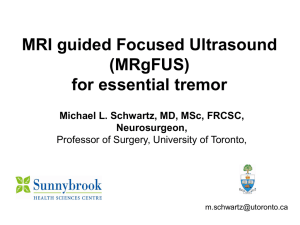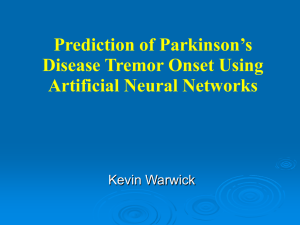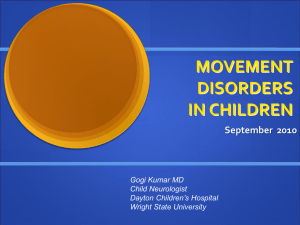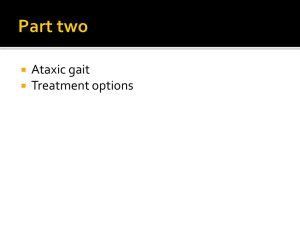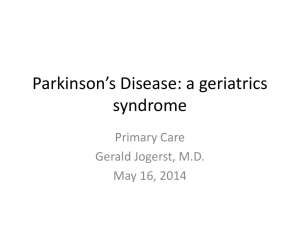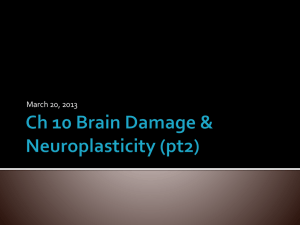Halim Fadil, MD - Kane Hall Barry Neurology
advertisement
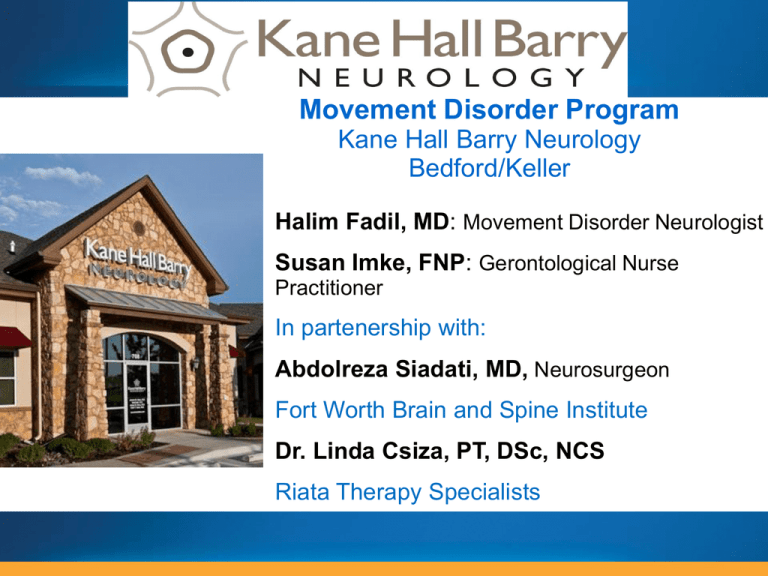
Movement Disorder Program Kane Hall Barry Neurology Bedford/Keller Halim Fadil, MD: Movement Disorder Neurologist Susan Imke, FNP: Gerontological Nurse Practitioner In partenership with: Abdolreza Siadati, MD, Neurosurgeon Fort Worth Brain and Spine Institute Dr. Linda Csiza, PT, DSc, NCS Riata Therapy Specialists • Neurology Residency: LSU Shreveport, LA • Neurophysiology Fellowship: UC Davis • Movement Disorders Fellowship: Cedars-Sinai Medical Center, Los Angeles, CA With Dr. Michele Tagliati What Is Essential Tremor? • ET is a neurologic disorder characterized by uncontrollable shaking or tremor • Essential means − There is no other cause for tremor − There are no other neurologic signs What causes ET? • The true cause of ET is still not understood • Also known as “familial tremor” • Genetics is responsible in 50% of the people with the condition How common is ET? • The most common movement disorder • Affects as many as 7.6 million people in the US • About 2.2 % of the US population • 5% of people age > 65 y have ET Louis ED and Ottman R. How many people in the USA have Essential Tremor? Deriving a Population Estimate based on Epidemiological Data. Tremor Other Hyperkinet Mov 2014 Celebrities with ET • Late senator Robert Byrd • John Adams: 2nd US President • John Q. Adams: 6th US President • Actress Katharine Hepburn Who gets ET? • Can occur at any age, however there is a bimodal distribution with peaks in the second and sixth decades (1, 2) Bain et al. A study of heredity of essential tremor. Brain 1994 (1) Lou and Jankovitch. Essential tremor: Clinical correlates in 350 patients. Neurology 1991 (2) Manifestations of ET • Bilateral tremor of the hands and forearms • May also involve the head, voice ,and sometimes legs and trunk • Postural and kinetic (associated with action) tremor • Tremor usually worsens with emotional stress and may improve with alcohol Bain P, et al. Criteria for the diagnosis of essential tremor. Neurology 200 Manifestations of ET •Functional disabilities in basic and instrumental activities of daily living • Balance problems with risk of fall in some cases • Non-motor features: – Mild cognitive impairment – Mood disorders: Anxiety, depression (1) – Sleep disturbance, ?Rapid eye movement sleep behavior disorder – ?Reduction of sense of smell (1) Sinoff and Badarny. Tremor other Hyperkinet Mov 2014. Manifestations of ET • Tremor starts insidiously and progresses slowly • ET is not dangerous but can be disabling Diagnosis • Clinical: Based on symptoms • There is no lab test or radiological scan • Rule-out other conditions and medications that may cause a tremor Other Causes of Tremor • Drug induced: Caffeine, Amphetamines, Prozac, Lithium, Lipitor, Depakote, Amiodarone, Verapamil • Electrolyte imbalance: Low Ca, Low Na • Thyroid dysfunction • Parkinson’s Disease • Post traumatic tremor • Multiple Sclerosis • Physiologic tremor Misdiagnosis of ET and PD is Common •Clinical studies have found a high level of misdiagnosis of ET and PD • A previous diagnosis of PD was rejected in 15% of patients using standardized criteria and > 1 year follow-upa • ~26% of patients receiving antiparkinsonian medication did not have a parkinsonian syndromeb • A previous diagnosis of ET was rejected in 37% of patients using standardized criteriac a. Schrag A, et al; b. Meara J, et al; c. Jain S, et al Is ET Related to PD? • NO, NO, NO • ET tremor differs from PD • ET patients do not feel slow or stiff • ET patients do not have difficulty walking • ET does not progress into PD • Some patients can have both diagnoses Areas of Uncertainty Definite PDa Asymmetric tremor Areas of Clinical Uncertaintyb-f Mixed tremor types Resting tremor Questionable bradykinesia Bradykinesia (Slowness) Questionable response to dopaminergic therapy Rigidity (Stiffness) Definite ETg Symmetric tremor Postural and kinetic (action) tremor Voice or head tremor Family history of tremor Ambiguous/Overlapping Symptoms PD symptoms ET symptoms + postural and kinetic tremors + symmetric tremor + symmetric tremor + rest tremor + no bradykinesia (slowness) + cogwheeling present + no rigidity (stiffness) DaT Scan: SPECT Images Normal Early Parkinson’s D Reduction of the dopamine transporter correlates with the loss of presynaptic Dopamine seen in parkinsonian syndromes Case Presentation • Woman age 60 y presents for evaluation of a longstanding tremor • -7year history of bilateral symmetric hand tremor that occurs with activity and is especially bothersome when she writes or holds a cup • Tremor improves with wine. Her father had a similar tremor • Not bothersome but has increased in past several months • Recently noticed occasional right-arm tremor at rest Case Presentation (cont) • Neurologic examination • Bilateral action tremor when she holds a cup • Slight rest tremor component in the right arm • Trace of increased tone in the right wrist • Normal balance and gait • No other medical history Case Conclusion • The patient had a history of long-standing ET supported by a positive family history (present in 50% of patients) and response to alcohol • In addition to the bilateral action tremor typical of ET, the examination demonstrates subtle features of asymmetric rest tremor, suggestive of early PD • The clinical diagnosis is ET but you are concerned that she may have early PD in addition • Two possible approaches − Clinical follow-up to see if she develops clearer features of parkinsonism − Obtain a dopamine transporter SPECT scan • Patient elects to have the SPECT scan − SPECT demonstrates normal dopamine uptake − ET is confirmed Summary • ET and PD are clinical diagnoses, but symptoms can sometimes overlap, causing misdiagnosis • Timely and accurate diagnosis of PD and ET will advance appropriate treatment and improve the patient’s quality of life • Patients with atypical symptoms may benefit from dopamine transporter SPECT to differentiate between a parkinsonian syndrome and ET Treatment of Essential Tremor • There is no cure • Treatment is symptomatic. Approaches to treatment • Physical and psychological measures • Lifestyle modifications • Pharmacologic treatments • Botulinum toxin injection • Deep Brain Stimulation surgery Approaches to treatment • The selection of treatment options must be based on individual needs, taking into account patient history, tremor severity, coexistent diseases, current medications, response to previous therapy, and other factors. Approaches to treatment: No treatment • Because no therapies are known to prevent or slow the natural progression of ET • Treatment is recommended only when tremor begins to interfere with a patient's ability to perform ADLs or leads to social embarrassment • No treatment may be the best option if functional disability is minimal Approaches to treatment: • Physical measures: Weighted wrist cuffs, weighted utensils • Psychological measures: Relaxation therapy • Lifestyle changes: – Restricting caffeine intake and other stimulants. – Alcohol may improve the tremor, so BEWARE of alcohol abuse Antihypertensive Medications • These include beta blockers and calcium channel blockers and are used to treat hypertension and other cardiovascular conditions. • Two clinical studies suggest that propranolol (Inderal) reduces tremor in patients with ET. • Others include atenolol (Tenormin) and sotalol (Sotacor). Antihypertensive agents • Propanolol (Inderal) is a first line agent for ET • Dose: 60 mg to 320 mg daily • Response rate: 50% to 70% • Tremor improvement: 50% • Dropout rate: 20% • Side effects: Drop of blood pressure, bradycardia, fatigue, erectile dysfunction, drowsiness, dyspnea seen in 60% Antiepileptics • Primidone (Mysoline) is a first line agent for ET • Dose: 250 mg to 750 mg daily • Response rate: 30% to 50% • Tremor improvement: 50% to 70% • Dropout rate: 20% to 30% • Side effects: Sedation, fatigue, dizziness, confusion, nausea, flu-like symptoms seen in 22% to 72% Antiepileptics • Topiramate (Topamax) is a second line agent for ET • Dose: 150 mg to 300 mg daily • Response rate: 30% to 40% • Tremor improvement: 20% to 37% • Dropout rate: 30% • Side effects: Paresthesias, sedation, fatigue, weight loss, dizziness, confusion, nausea, seen in 50% Antiepileptics • Gabapentin (Neurontin) is a second line agent for ET • Dose: 1200 mg to 3600 mg daily • Response rate: 30% • Tremor improvement: 30% to 40% • Dropout rate: 10% • Side effects: Sedation, weight gain, dizziness, nausea seen in 30% to 40% Antiepileptics • Pregabalin (Lyrica) is a second line agent for ET • Dose: 150 mg to 600 mg daily • Response rate: 30% to 50% • Tremor improvement: 30% to 40% • Dropout rate: 10% • Side effects: Sedation, weight gain, dizziness, nausea seen in 30% to 40% Benzodiazepines • Clonazepam (Klonopin) is a second line agent for ET • Dose: 0.5 mg to 4 mg daily • Response rate: 50% to 70% • Tremor improvement: 30% to 50% • Dropout rate: 10% • Side effects: Sedation, cognitive impairment, Tolerance, dependance, abuse seen in 50% Antipsychotics • Clozapine (Clozaril) ) is an atypical neuroleptic with minimal extrapyramidal side effects that has been shown to reduce tremor by 45-50% in two controlled studies. Third line agent • However, clozapine use has a 1% risk of agranulocytosis, a serious side effect, and its use should be reserved for refractory cases. Botulinum Toxin • Chemodenervation using botulinum toxin A (Botox) has been demonstrated to reduce hand and head tremor in patients with ET. • Its use is hampered by side effects including hand weakness. • Two controlled studies and 4 uncontrolled studies demonstrated improvement in limb tremor with BTX. Treatment of Essential Tremor • About 30 % to 50 % of ET patients will not respond to medical therapy Surgical Treatment • Thalamotomy is a stereotactic procedure that creates a lesion in the ventral intermediate nucleus (VIM) of the thalamus. • Studies have typically reported an 80–90% improvement in tremor symptoms compared to baseline. Surgical Treatment • Deep brain stimulation (DBS) uses high frequency electrical stimulation from an implanted electrode to modify activity in the target area, usually the VIM thalamus. • The electrode is connected to a pulse generator which is implanted in the chest wall. • DBS is usually reserved for patients who are refractory to pharmacotherapy. Deep Brain Stimulation Indications of surgery? • Certainty of diagnosis • Severe symptoms with related disability • Proper trial of pharmacological treatment DBS anatomical Target • Ventral Intermediate nucleus of the thalamus Deep Brain Stimulation Advantages • Does not involve destructive brain lesions • Bilateral procedures associated with minimal risk • Stimulation settings can be adjusted to maximize benefit and minimize adverse effects • Does not preclude future therapies that depend on the integrity of the basal ganglia Olanow et al. Neurology. 2001;56(suppl 5):S1-S88. Deep Brain Stimulation Disadvantages • Mechanical and infectious adverse effects associated with implanted device • Need to periodically replace battery • High cost Olanow et al. Neurology. 2001;56(suppl 5):S1-S88. Coping tips for daily living • Learn to use your tremor-free hand • Hold your chin toward your chest or turn your head to the side to control the tremor • Use travel mugs with lids • Carry straws with you • Avoid caffeine, ephedra, and any OTC meds that may increase the heart rate • Keep your elbows close to your body when performing tasks Coping tips for daily living • Stress control: Massage therapy,.. • In restaurants, request that your meat be cut in the kitchen, avoid buffets.. • Use heavier glasses and mugs, dishes with vertical sides • Use an electric toothbrush • Print rather than write script, write in small letters Be who you are and say what you feel because those who matter don’t mind and those that mind don’t matter -Dr. Seuss Thank you


